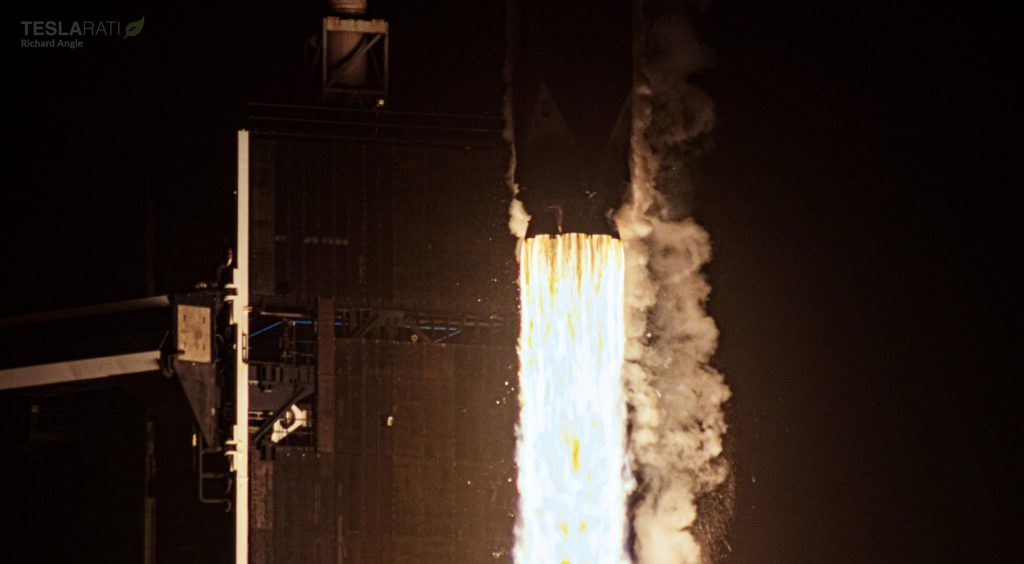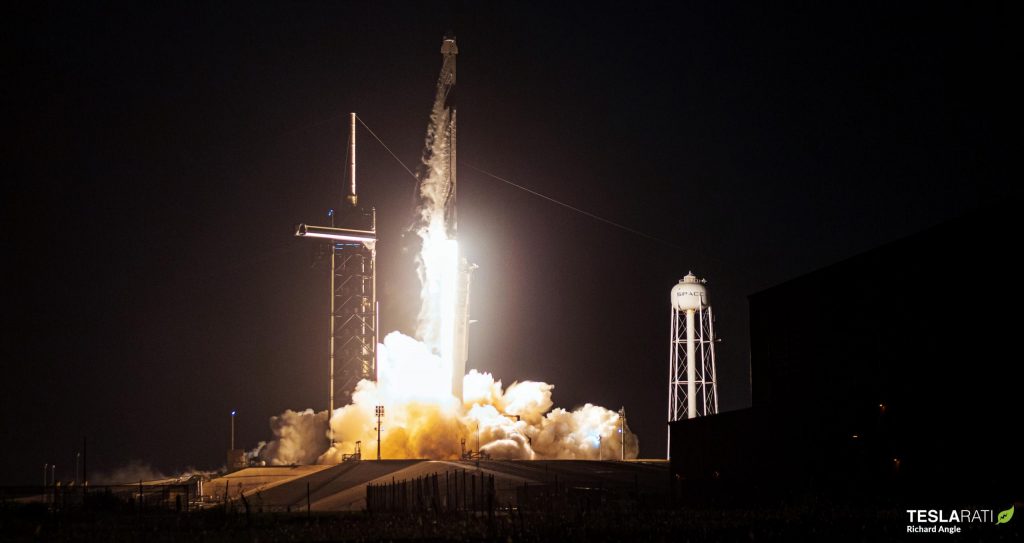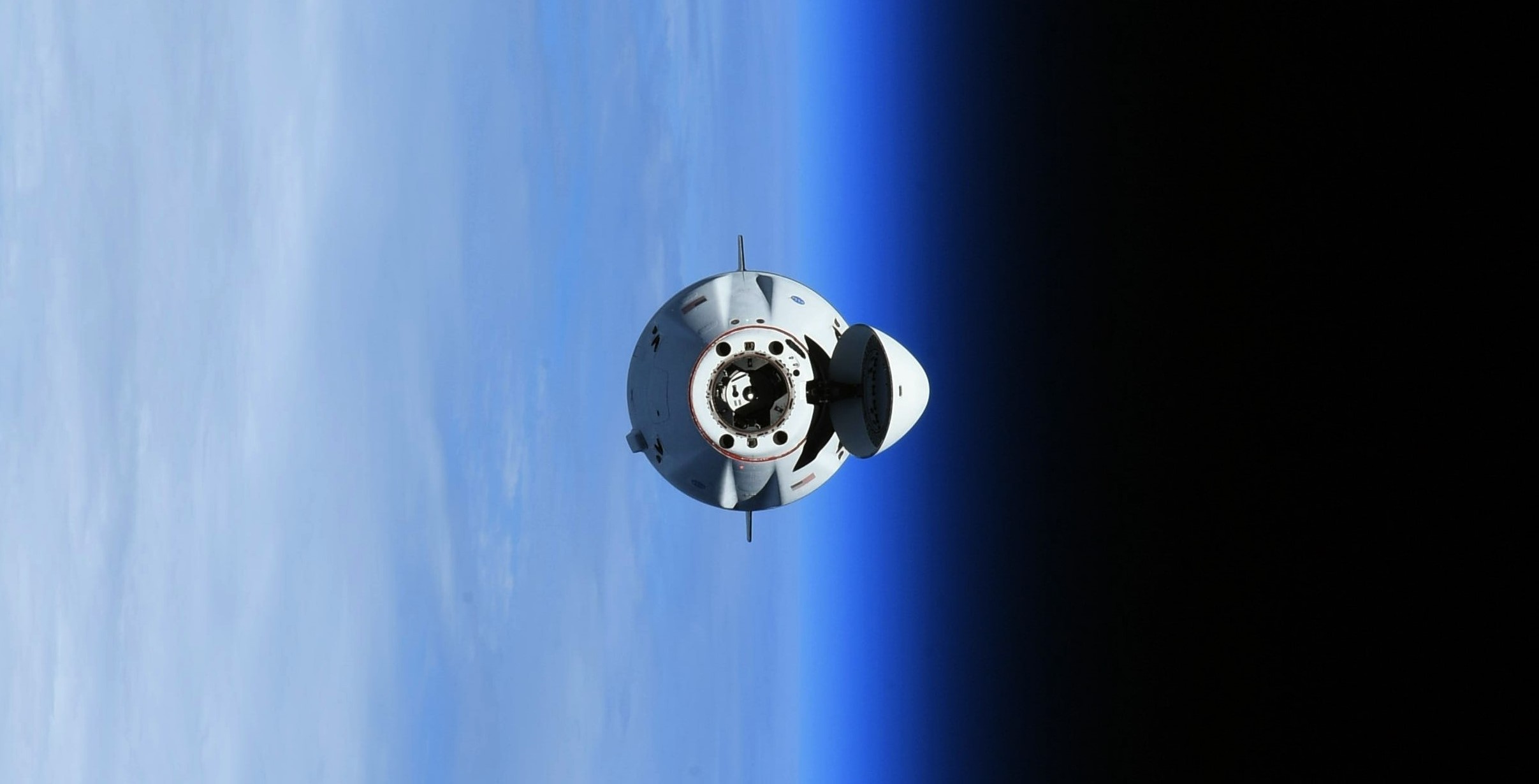For the fourth time in nine months, SpaceX has docked a Dragon spacecraft to the International Space Station with a second Dragon already present at the crewed orbital laboratory.
Launched Saturday on a Falcon 9 rocket after a one-day weather delay, SpaceX’s first upgraded Cargo Dragon 2 spacecraft gradually boosted and tweaked its orbit over the course of ~30 hours, looping around the Earth 20+ times before docking with the ISS more than half an hour ahead of schedule. Dragon’s Monday, August 30th arrival marked cargo capsule C208’s second space station docking in nine months, smashing SpaceX and the world’s turnaround record for a reusable orbital space capsule – of which Dragons are the only still flying.
SpaceX’s first twice-flown Crew Dragon was there to greet the first twice-flown Cargo Dragon 2 spacecraft when it docked, having spent the last four months in orbit in support of NASA’s second operational commercial crew mission (Crew-2). A similar instance of a pair Dragons meeting in space is likely to occur at least two more times before the end of 2021.


The first two-Dragons-one-ISS instance occurred just nine months ago when the very same Cargo Dragon 2 spacecraft (capsule C208) rendezvoused and docked with the ISS with SpaceX’s Crew-1 Crew Dragon already attached. At the time, in a number of press conferences and public statements centered around the launch of Crew-1 and CRS-21, SpaceX repeatedly hinted at just how prolific a year 2021 would be for Dragon and it’s hard to argue that the company was exaggerating.
Indeed, exactly as SpaceX foretold, Dragon spacecraft have maintained a continuous presence in orbit and repeatedly operated side by side at the ISS since Crew-1’s November 2021 launch. For the majority of NASA’s Commercial Crew Program development, that degree of continuous, single-provider operations was never meant to happen. SpaceX’s upgraded Cargo Dragon, for example, is one of two independent Commercial Resupply Services (CRS) spacecraft that regularly resupply the space station, ensuring redundancy in the event that one spacecraft or rocket runs into major issues. A third CRS vehicle – Sierra Nevada’s Dream Chaser spaceplane – will also begin cargo deliveries sometime next year.
NASA’s Commercial Crew Program was structured in the same way, with Boeing and SpaceX serving as two redundant crew transport providers. Of course, things didn’t go exactly according to plan and Boeing – despite receiving 60% (~$2B) more funding than SpaceX – has suffered numerous catastrophic issues in recent years, nearly dooming its Starliner spacecraft’s first uncrewed launch in December 2019 and ultimately delaying the company by two or more years.
After further issues delayed Starliner’s uncrewed do-over test flight (OFT-2) from August to late 2021 or early 2022, it’s entirely possible that SpaceX will operate as NASA’s sole crew transport solution for more than 18 months before Boeing flies a single astronaut. In other words, it’s likely that SpaceX will need to maintain the extraordinary cadence of Dragon launches demonstrated in 2021 well into 2022, and possibly even 2023. Since November 2020, SpaceX has launched three Cargo Dragon 2 resupply missions and eight astronauts on two Crew Dragons.
Another two NASA Dragon missions – Crew-3 and CRS-24 – are scheduled to launch in October and December 2021 and SpaceX’s first fully private Inspiration4 Crew Dragon launch could happen as early as September 15th. So long as Boeing’s Starliner is unable to fulfill its crew transport role, all future SpaceX Crew and Cargo missions for NASA – including Crew-3 and CRS-24 – will continue to see one Dragon meet another at the ISS. All told, barring possible delays to CRS-24, SpaceX is on track to launch eight Dragons – four Crew and four Cargo; 16 astronauts and 11 tons of space station supplies – in 13 months.
If Crew Dragon and Cargo Dragon 2 are considered to be two variants of the same Dragon 2 spacecraft, the only other instance in history where another orbital spacecraft came close to eight successful orbital launches in ~13 months was NASA’s Gemini Program, which completed eight crewed test flights in ~14 months in 1965 and 1966.
NASA’s Apollo spacecraft also completed six successful flights (5 crewed, 1 uncrewed) in 13 months in 1968 and 1969. Russian Soyuz vehicles – the most prolific crewed spacecraft in history – have also successfully flown 8 times in 13 months and 9 times in 14 months in the 1970s. Put simply, SpaceX’s Dragon program is now singlehandedly executing at or above the level of the two most prolific national space programs in history at funding peaks that haven’t been touched since and for a fraction of the cost.
News
Tesla UK sales see 14% year-over-year rebound in June: SMMT data
The SMMT stated that Tesla sales grew 14% year-over-year to 7,719 units in June 2025.

Tesla’s sales in the United Kingdom rose in June, climbing 14% year-over-year to 7,719 units, as per data from the Society of Motor Manufacturers and Traders (SMMT). The spike in the company’s sales coincided with the first deliveries of the updated Model Y last month.
Model Y deliveries support Tesla’s UK recovery
Tesla’s June performance marked one of its strongest months in the UK so far this year, with new Model Y deliveries contributing significantly to the company’s momentum.
While the SMMT listed Tesla with 7,719 deliveries in June, independent data from New AutoMotive suggested that the electric vehicle maker registered 7,891 units during the month instead. However, year-to-date figures for Tesla remain 2% down compared to 2024, as per a report from Reuters.
While Tesla made a strong showing in June, rivals are also growing. Chinese automaker BYD saw UK sales rise nearly fourfold to 2,498 units, while Ford posted the highest EV growth among major automakers, with a more than fourfold increase in the first half of 2025.
Overall, the UK’s battery electric vehicle (BEV) demand surged 39% to to 47,354 units last month, helping push total new car sales in the UK to 191,316 units, up 6.7% from the same period in 2024.
EV adoption accelerates, but concerns linger
June marked the best month for UK car sales since 2019, though the SMMT cautioned that growth in the electric vehicle sector remains heavily dependent on discounting and support programs. Still, one in four new vehicle buyers in June chose a battery electric vehicle.
SMMT Chief Executive Mike Hawes noted that despite strong BEV demand, sales levels are still below regulatory targets. “Further growth in sales, and the sector will rely on increased and improved charging facilities to boost mainstream electric vehicle adoption,” Hawes stated.
Also taking effect this week was a new US-UK trade deal, which lowers tariffs on UK car exports to the United States from 27.5% to 10%. The agreement could benefit UK-based EV producers aiming to expand across the country.
News
Tesla Model 3 ranks as the safest new car in Europe for 2025, per Euro NCAP tests
Despite being on the market longer than many of its rivals, the Tesla Model 3 continues to set the bar for vehicle safety.

The Tesla Model 3 has been named the safest new car on sale in 2025, according to the latest results from the Euro NCAP. Among 20 newly tested vehicles, the Model 3 emerged at the top of the list, scoring an impressive 359 out of 400 possible points across all major safety categories.
Tesla Model 3’s safety systems
Despite being on the market longer than many of its rivals, the Tesla Model 3 continues to set the bar for vehicle safety. Under Euro NCAP’s stricter 2025 testing protocols, the electric sedan earned 90% for adult occupant protection, 93% for child occupant protection, 89% for pedestrian protection, and 87% for its Safety Assist systems.
The updated Model 3 received particular praise for its advanced driver assistance features, including Tesla’s autonomous emergency braking (AEB) system, which performed well across various test scenarios. Its Intelligent Speed Assistance and child presence detection system were cited as noteworthy features as well, as per a WhatCar report.
Other notable safety features include the Model 3’s pedestrian-friendly pop-up hood and robust crash protection for both front and side collisions. Euro NCAP also highlighted the Model 3’s ability to detect vulnerable road users during complex maneuvers, such as turning across oncoming traffic.
Euro NCAP’s Autopilot caution
While the Model 3’s safety scores were impressive across the board, Euro NCAP did raise concerns about driver expectations of Tesla’s Autopilot system. The organization warned that some owners may overestimate the system’s capabilities, potentially leading to misuse or inattention behind the wheel. Even so, the Model 3 remained the highest-scoring vehicle tested under Euro NCAP’s updated criteria this year.
The Euro NCAP’s concerns are also quite interesting because Tesla’s Full Self-Driving (FSD) Supervised, which is arguably the company’s most robust safety suite, is not allowed for public rollout in Europe yet. FSD Supervised would allow the Model 3 to navigate inner city streets with only minimal human supervision.
Other top scorers included the Volkswagen ID.7, Polestar 3, and Geely EX5, but none matched the Model 3’s total score or consistency across categories. A total of 14 out of 20 newly tested cars earned five stars, while several models, including the Kia EV3, MG ZS, and Renault 5, fell short of the top rating.
Elon Musk
Why Tesla’s Q3 could be one of its biggest quarters in history
Tesla could stand to benefit from the removal of the $7,500 EV tax credit at the end of Q3.

Tesla has gotten off to a slow start in 2025, as the first half of the year has not been one to remember from a delivery perspective.
However, Q3 could end up being one of the best the company has had in history, with the United States potentially being a major contributor to what might reverse a slow start to the year.
Earlier today, the United States’ House of Representatives officially passed President Trump’s “Big Beautiful Bill,” after it made its way through the Senate earlier this week. The bill will head to President Trump, as he looks to sign it before his July 4 deadline.
The Bill will effectively bring closure to the $7,500 EV tax credit, which will end on September 30, 2025. This means, over the next three months in the United States, those who are looking to buy an EV will have their last chance to take advantage of the credit. EVs will then be, for most people, $7,500 more expensive, in essence.
The tax credit is available to any single filer who makes under $150,000 per year, $225,000 a year to a head of household, and $300,000 to couples filing jointly.
Ending the tax credit was expected with the Trump administration, as his policies have leaned significantly toward reliance on fossil fuels, ending what he calls an “EV mandate.” He has used this phrase several times in disagreements with Tesla CEO Elon Musk.
Nevertheless, those who have been on the fence about buying a Tesla, or any EV, for that matter, will have some decisions to make in the next three months. While all companies will stand to benefit from this time crunch, Tesla could be the true winner because of its sheer volume.
If things are done correctly, meaning if Tesla can also offer incentives like 0% APR, special pricing on leasing or financing, or other advantages (like free Red, White, and Blue for a short period of time in celebration of Independence Day), it could see some real volume in sales this quarter.
You can now buy a Tesla in Red, White, and Blue for free until July 14 https://t.co/iAwhaRFOH0
— TESLARATI (@Teslarati) July 3, 2025
Tesla is just a shade under 721,000 deliveries for the year, so it’s on pace for roughly 1.4 million for 2025. This would be a decrease from the 1.8 million cars it delivered in each of the last two years. Traditionally, the second half of the year has produced Tesla’s strongest quarters. Its top three quarters in terms of deliveries are Q4 2024 with 495,570 vehicles, Q4 2023 with 484,507 vehicles, and Q3 2024 with 462,890 vehicles.
-

 Elon Musk4 days ago
Elon Musk4 days agoTesla investors will be shocked by Jim Cramer’s latest assessment
-

 News1 week ago
News1 week agoTesla Robotaxi’s biggest challenge seems to be this one thing
-

 Elon Musk2 weeks ago
Elon Musk2 weeks agoFirst Look at Tesla’s Robotaxi App: features, design, and more
-

 News2 weeks ago
News2 weeks agoSpaceX and Elon Musk share insights on Starship Ship 36’s RUD
-

 News2 weeks ago
News2 weeks agoWatch Tesla’s first driverless public Robotaxi rides in Texas
-

 News1 week ago
News1 week agoWatch the first true Tesla Robotaxi intervention by safety monitor
-

 News2 weeks ago
News2 weeks agoTesla has started rolling out initial round of Robotaxi invites
-

 Elon Musk2 weeks ago
Elon Musk2 weeks agoTesla to launch in India in July with vehicles already arriving: report



















